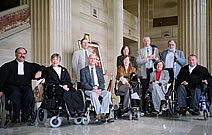Act Now

Empower U: Learn to Access Your Disability Rights Training on Canadian Human Rights, the Convention on the Rights of Persons with Disabilities (CRPD) and its Optional Protocol (OP) training aims to increase awareness of how to address discrimination using more familiar Canadian human rights laws such as Human Rights Codes and the newer international Convention on the Rights of Persons with Disabilities (CRPD). This is training for persons with disabilities by persons with disabilities. The training is part of a project funded by Employment and Social Development Canada and implemented by the Council of Canadians with Disabilities (CCD) in collaboration with Canadian Multicultural Disability Centre Inc. (CMDCI), Citizens With Disabilities – Ontario (CWDO), Manitoba League of Persons with Disabilities (MLPD) and National Educational Association of Disabled Students (NEADS). Read more.
Sign Up for our monthly digest
A monthly newsletter from CCD about what is happening in the community
Regulation of Federal Transportation System for Access
Related Documents
October 12, 2023
Travelling to the North to Gather Information towards Developing CTA Accessibility Regulations for Small Carriers and Terminals Not Covered by the Accessible Transportation for People with Disabilities Regulation (ATPDR)
March 15, 2018
Bill C-49 Empowers Goliath and Takes Away David's Sling Shot
March 14, 2018
Transportation Modernization Act (Bill C-49)
January 18, 2010
Open Letter to Members of Parliament
In February, elite athletes with disabilities, who will be participating in the Paralympics, will be experiencing Canada’s transportation system. We hope that they encounter transportation services that are barrier free and allow for independent and dignified use. Indeed, this is CCD’s goal for all travelers with disabilities. CCD, the Council of Canadians with Disabilities, is a human rights organization of persons with disabilities. We are concerned that recent developments in the transportation sector combined with long-term shortcomings in the regulatory system threaten this goal.
The 25 December 2009 terrorist incident on an American airline is causing governments to implement changes in screening practices around the world. CCD is concerned about how these new practices will impact travelers with various types of disabilities. For example, will new scanning equipment be usable by people with disabilities in an independent and dignified manner? In light of past experiences in the Canadian transportation system our concerns are justified. As VIA Rail’s purchase of inaccessible passenger cars demonstrated, the needs of travelers with disabilities often are not a first priority for transportation administrators.
To ensure the needs of travelers with disabilities are attended to as new transportation policies, programs and services are developed, Canada requires regulations which would uphold accessibility for people with disabilities as a priority whenever changes are made in Canada’s federal transportation system. This would prevent the creation of new barriers to the mobility of persons with disabilities and uphold the Supreme Court’s ruling in VIA of not creating new barriers. CCD seeks both to eliminate existing barriers and prevent the creation of new obstacles. CCD, and many other organizations in the disability community, have been calling upon the federal government to adopt accessibility regulations and once again CCD renews this call.
Regulations in support of access to transportation systems by people with disabilities are in place in other developed countries including the United States and Britain – both of whom have implemented a system of regulation for access. Once a leader in transportation access for people with disabilities, Canada’s policy framework for ensuring accessible transportation now lags behind practices in other countries. For your information, attached is a link to the international comparative report, "Moving Backwards" by David Baker which demonstrates how Canada’s approach to transportation access is less robust than that of other similar countries.
I encourage you to collaborate with the disability community for the achievement of robust accessibility regulations that will eliminate barriers to the mobility of persons with disabilities.
Sincerely,
Marie White
Chairperson

CCD wins VIA Rail case at the Supreme Court of Canada on March 23, 2007.
